I'm trying to display a filled contour using the cv2.drawContours function in OpenCV. I've developed a list of contours from an edge image derived from a Canny detection, and am finding the contours with RETR_EXTERNAL enabled for the hierarchy definition. However I'm running into an issue that despite using the -1 flag in the cv2.drawContours command to indicate a filled contour, only the contour itself(i.e. edge) is displayed. For example:
mask = np.zeros(rawimg.shape, np.uint8)
cv2.drawContours(mask, contours[246], -1, (0,255,255), -1)
results in just the outline of contour 246 being displayed. As I am only retrieving the external contours I don't think I am seeing just the difference between the internal and external contours found at each edge, so I'm a bit confused as to why it is displaying the contour, but not filling as the -1 flag would suggest it should.
EDIT: The full code is included below. The issue is with the line: cv2.drawContours(mask, cnt, 2, (0,255,255), -1) While this is formatted in the manner suggested by Dan, it results in the following image:
 . cnt is a single contour, so this makes sense that it would be referring to a single point in the contour. When the line is changed to:
. cnt is a single contour, so this makes sense that it would be referring to a single point in the contour. When the line is changed to:
cv2.drawContours(mask, cnt, -1, (0,255,255), -1)
the contour prints as before, however the contour is still not filled as the -1 flag at the end of the command would suggest it should be.
The test image:
import os
import cv2
import numpy as np
from matplotlib import pyplot as plt
import copy as cp
path = 'C:\\Users\\...deleted...\\Desktop\\testimage6.jpg'
#Determine largest contour in the image
def maxContour(contours):
cnt_list = np.zeros(len(contours))
for i in range(0,len(contours)):
cnt_list[i] = cv2.contourArea(contours[i])
max_value = np.amax(cnt_list)
max_index = np.argmax(cnt_list)
cnt = contours[max_index]
return cnt, max_index
if os.path.isfile(path):
# Import the raw image to a working location and save to an isolated variable
# Import the raw image to a working location and save to an isolated variable
img = cv2.imread(path)
rawimg = cv2.imread(path)
saveimg = cv2.imread(path)
imgray = cv2.cvtColor(saveimg, cv2.COLOR_BGR2GRAY)
saveimgray = cp.copy(imgray)
f1 = plt.figure(1)
f1.set_size_inches(8,10)
plt.title('Original Image')
plt.xticks([]), plt.yticks([])
plt.imshow(rawimg, cmap='gray')
plt.savefig('output1.jpg', dpi=300)
cv2.imshow('Raw Image',rawimg)
cv2.waitKey(0)
cv2.destroyWindow('Raw Image')
# Impose an opening function as a filter
kernel = np.ones((3,3),np.uint8)
opening = cv2.morphologyEx(img, cv2.MORPH_OPEN, kernel)
f2 = plt.figure(2)
f1.set_size_inches(8,10)
plt.title('Opened Image')
plt.xticks([]), plt.yticks([])
plt.imshow(opening, cmap='gray')
plt.savefig('output2.jpg', dpi=300)
cv2.imshow('Opened Image', opening)
cv2.waitKey(0)
cv2.destroyWindow('Opened Image')
#Extract the edges from the filtered image
edges = cv2.Canny(opening,10,100)
cv2.imshow('Edges', edges)
cv2.waitKey(0)
cv2.destroyWindow('Edges')
f3=plt.figure(3)
f3.set_size_inches(16,8)
plt.title('Edge Image')
plt.xticks([]), plt.yticks([])
plt.imshow(edges, cmap='gray')
plt.savefig('output3.jpg', dpi=300)
#Detect contours in the edge image
image, contours, hierarchy = cv2.findContours(edges, cv2.RETR_EXTERNAL, cv2.CHAIN_APPROX_NONE)
cv2.drawContours(img, contours, -1, (0,255,255), 2)
cv2.imshow('Contours Image', img)
cv2.waitKey(0)
cv2.destroyWindow('Contours Image')
f4=plt.figure(4)
f4.set_size_inches(16,8)
plt.title('Contour Image')
plt.xticks([]), plt.yticks([])
plt.imshow(img)
plt.savefig('output2.jpg', dpi=300)
#Find maximum area contour
cnt, max_index = maxContour(contours)
print(max_index)
# Calculate contour-based statistics
# TBD
#Test of removing max contour
#grayimg = cv2.cvtColor(rawimg, cv2.COLOR_BGR2GRAY)
mask = np.zeros(rawimg.shape, np.uint8)
cv2.drawContours(mask, cnt, 2, (0,255,255), -1)
#ret, mask = cv2.threshold(grayimg, 10, 255, cv2.THRESH_BINARY)
mask_inv = cv2.bitwise_not(mask)
cv2.imshow('Mask Image', mask)
cv2.waitKey(0)
cv2.destroyWindow('Mask Image')
cv2.imshow('Mask Image', mask_inv)
cv2.waitKey(0)
cv2.destroyWindow('Mask Image')
#Fit ellipse to contour and calculate ellipse statistics
(x,y), (w,h), angle = cv2.fitEllipse(cnt)
rect = cv2.minAreaRect(cnt)
box = cv2.boxPoints(rect)
box = np.int0(box)
x = np.int0(x)
y = np.int0(y)
w = np.int0(0.5*w)
h = np.int0(0.5*h)
#output2 = cv2.ellipse(img, center, dim, angle, 0, 360, (255,0,0), 12)
output2 = cv2.ellipse(img, (x,y), (w,h), angle, 0, 360, (255,0,0), 2)
output3 = cv2.drawContours(output2, [box], 0, (0,255,0), 2)
cv2.imshow('Ellipse Image',output2)
cv2.waitKey(0)
cv2.destroyWindow('Ellipse Image')
else:
print('file does not exist')`
